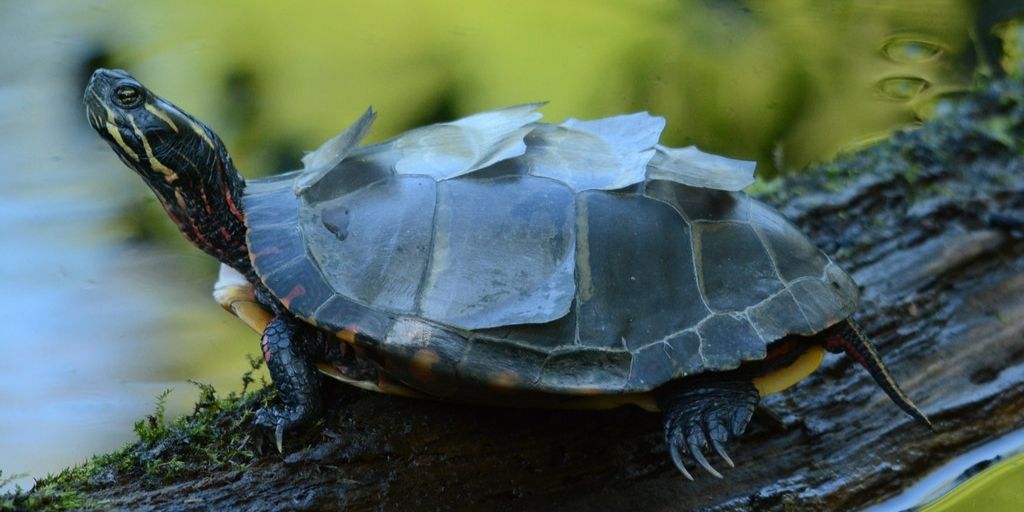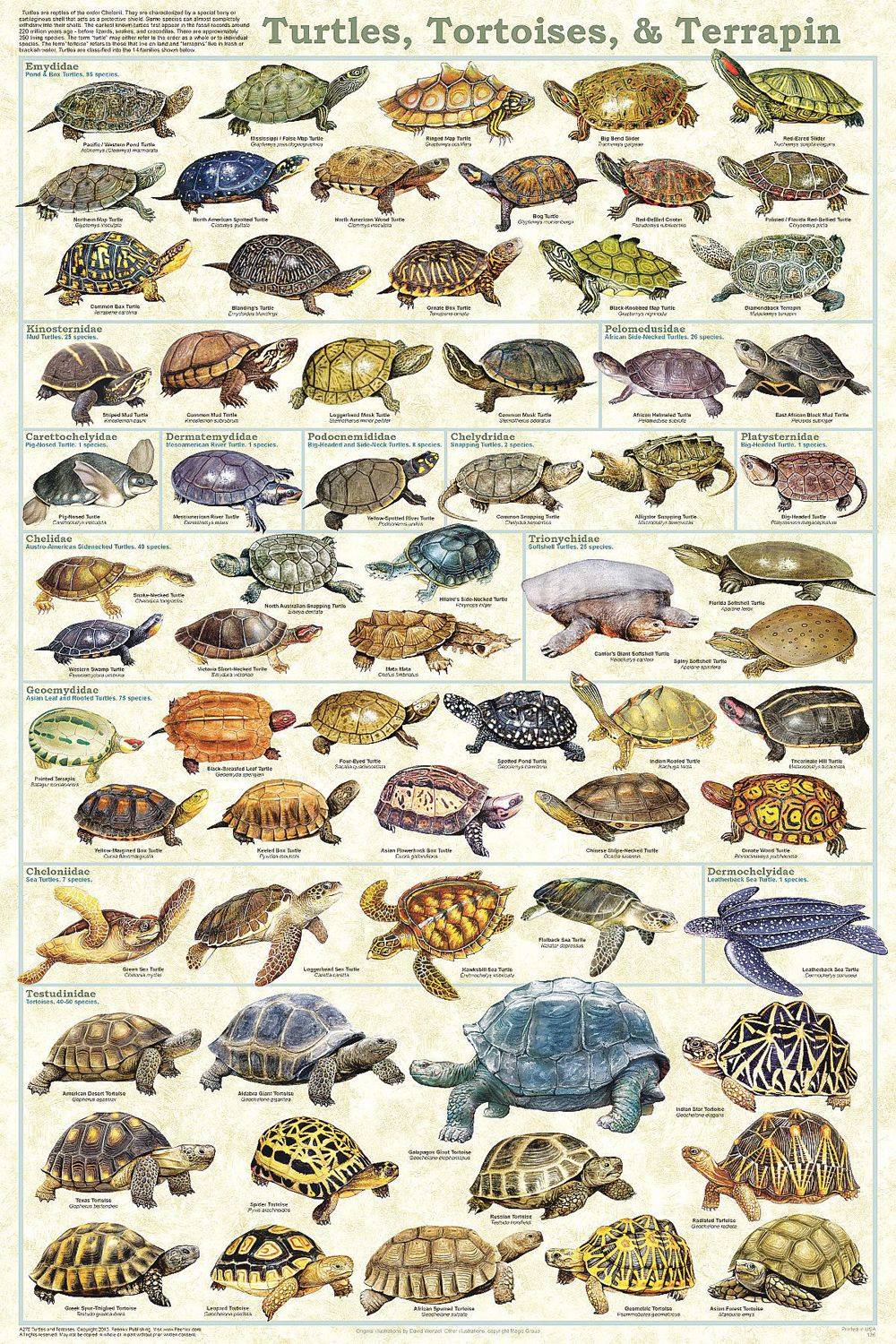Want to know the difference between turtle and tortoise? Whilst there are a handful of obvious distinctions between the two, the turtle vs tortoise debate can be quite complicated.
The common usage of the terms turtle and tortoise (and terrapin) varies geographically, and doesn’t usually reflect the scientific distinctions between these groups of animals. In common usage:
- Turtle is sometimes used to refer to the order of reptiles Testudines as a whole, sometimes to individual families that make up the order, and is sometimes limited to aquatic species only.
- Tortoise is used to refer to any non-swimming species of Testudines.
- Terrapin is used to describe any species of small, aquatic, hard-shelled turtles.
Whereas when it comes to a scientific definition, ‘turtle’ is the name for the Testiduines order which contains all 14 families and around 200 species of reptiles with shells on their back.
This means that strictly speaking all tortoises are turtles, but not all turtles are tortoises.
For clarity, this article explores the differences between the species in the family of tortoises (Testudinidae), and all of the other families in the Testiduines order, which we’ll refer to as ‘turtles’ for simplicity.
As might be expected, as closely related reptiles both turtles and tortoises have plenty of physical traits in common. Both turtles and tortoises:
- Are encased in a bony shell with scutes (thickened horny or boned plates) made of keratine.
- Have ribs and vertebrae that are fused to their shells.
- Have a pelvic girdle that sits inside their rib cage.
- Lay eggs on land into excavated nests of earth or sand.
- Are cold-blooded, relying on their environment to regulate their body processes.
- Have a hard beak rather than teeth.
With these similarities in mind, let’s now turn to look at the physical, behavioural, and geographic differences between tortoises and turtles that apply generally. Below we list the easiest ways to tells a turtle and a tortoise apart:
Key tortoise vs turtle difference: habitat
Perhaps the most critical difference between tortoise and turtle is that tortoises are terrestrial animals whilst turtles tend to live in water, or spend much or most of their time in water.
Tortoises aren’t equipped for water and live completely on land. Although they’re most commonly found in semi-arid habitats, they are able to live in a variety of diverse environments, including deserts, grasslands, scrub, and evergreen and wet tropical forests.
Turtles can be completely aquatic (aside from egg-laying), semi-aquatic, or mostly (but not completely) terrestrial. Sea turtles rarely leave the ocean, while freshwater turtles can be found living in and besides most aquatic environments – from ponds and lakes to rivers, swamps, and wetlands.
Physical differences between turtles and tortoises
Shell shape
As turtles generally live or spend lots of time in water their shells are relatively flat, thin, and streamlined, to help them swim and dive.
Tortoises are land-dwelling and have heavier, rounded, dome-shaped shells to provide protection from predators.
The exception to this rule are box turtles and some mud turtles which have dome-shaped shells.

A sea turtle (left) with sleek, flat shell, vs leopard tortoise with a high domed shell.
Scute shedding
Turtles shed their scutes to remove old growth and make room for new scutes to grow through underneath. One of the reasons they bask in the sun is to dry their scutes and help them flake off. If this doesn’t do the job, turtles can sometimes be seen rubbing their shells on trees or rocks to try to scrape the scutes off.
In contrast, tortoises don’t shed anything from their shells. Their keratin is constantly growing without shedding, pushing up old growth to give the shell a layered look. It’s thought this compounded growth helps bulk up their shells to protect them from predators.

Turtle tortoise? A turtle, as it’s sheds its scutes in the sun
Feet and leg shapes
One easy way to tell a turtle from a tortoise is to check out the legs and feet.
Tortoises have feet that are padded and stumpy, with horned, scaly toes, looking a little like tiny elephant feet. Their chunky elephantine legs help tortoises to carry their weight around on land.
Turtle feet are very different, being either webbed with long claws to help them latch onto floating objects and climb in and out of water, or in the case of aquatic turtles, there are true flippers rather than feet.
Again, box turtles are the exception to the role here, without webbed feet or flippers.

A snapping turtle (left) with webbed and clawed feet, vs the giant tortoise’s padded legs with elephantine toenails.
Other turtle and tortoise differences
Swimming ability
Tortoises stay away from water (except when drinking and bathing) because they can’t swim. They’re not designed for swimming, primarily because of their heavy, domed shells.
Turtles on the other hand – with their sleek body and shell shapes, and webbed feet or flippers – are built for aquatic life, and are excellent swimmers.
Range
Turtles and tortoises are found primarily in tropical and semi-tropical climates as they all require warm external temperatures.
Both turtles and tortoises are very adaptive animals, with turtles found on every continent except Antarctica, and tortoises found everywhere except Antarctica and Australasia.
The biggest variety of turtles are found in Southeastern North America and Asia, whilst the most diverse number of tortoise species can be found in Africa.
Diet – omnivore vs herbivore
Both tortoises and turtles need plenty of nutrients and minerals to promote healthy shell growth, but have evolved to have different diets.
Tortoises are primarily herbivores, with their diet varying depending on specific species and age. They tend to have a wide diet, slowly covering large distances, grazing on leaves, weeds, grasses, fruit, and vegetables as they come across them.
Turtles are omnivores, eating a similar variety of plants to tortoises, and supplementing this with protein sources ranging from worms and insects to jellyfish and small fish.

A sea turtle (left) devours a jellyfish, whilst a tortoise chews a lettuce leaf.
Lifespan
Tortoises are animals with extremely long lifespans – considerably longer than turtles.
The average lifespan for a turtle is around 30 years, with larger sea turtles averaging around 65 years.
Tortoises, by contrast, have an average lifespan of 90 years, with their lifespan generally linked to their size. Giant tortoises are renowned for living well over 100 years – possibly even over 200 years, The oldest currently living terrestrial animal is thought to be Jonathan, a Seychelles giant tortoise living on the island of Saint Helena, and reported to be 188 years old.

Turtle of tortoise? Jonathan (left), the world’s oldest tortoise, with a friend.
And that’s all for this round-up of turtle vs tortoise. What do you think – any differences turtles and tortoises that suprise you, additional differences we should add to this article? Please join in and let us know in the comments section below!

Chart showing common species of turtles, tortoises, and terrapins.



Eastern long-necked turtle (Australia)
Scientific Name: Chelodina longicollis
Some insist it is a Tortoise? can spend a lot of time on land, has webbed clawed feet